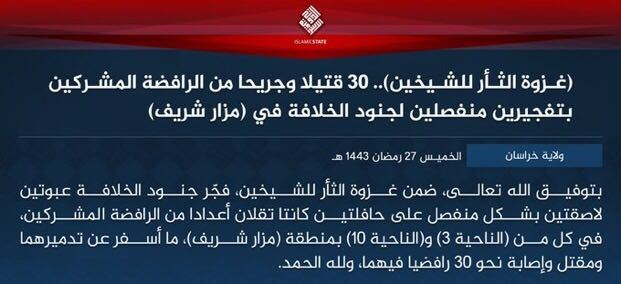On Thursday April 28, two explosions were detonated within minutes of each other in PD3 and PD10 in Mazar-e Sharif, Balkh province.
The area in PD10 is known to be home to a majority-Hazara Shia population, while the target in PD3 is reportedly a popular travel hub for Hazaras living in PD10. Both attacks reportedly targeted [GRAPHIC] buses transporting Hazara workers.
Mohammad Asif Waziri, a spokesman for a Taliban-appointed police chief, said the victims of the attack were travelling home to break their Ramadan fast, adding that “the targets appear to be Shia passengers.”
AW investigators have verified and geolocated both incidents in Mazar-e Sharif.
The first explosion was reported in PD10. The explosion was reportedly caused [GRAPHIC] by a magnetic IED attached to a minivan. According to FranceNews24, the explosion caused at least 22 casualties, with an estimated nine people killed and 13 wounded at the time of writing. Multiple examples of graphic footage shared on social media indicate at least four casualties.
 Figure 1: geolocation of explosion in PD10, exact coordinates: 36.707339, 67.148093
Figure 1: geolocation of explosion in PD10, exact coordinates: 36.707339, 67.148093
The second explosion was reported in PD3, near the Sultan Gheyasuddin High School. As with the first attack, the explosion was allegedly caused by a magnetic IED attached to a minivan. Graphic footage shared on social media indicates the explosion caused at least two casualties.
 Figure 2: geolocation of explosion in PD3, exact coordinates: 36.710031, 67.114303
Figure 2: geolocation of explosion in PD3, exact coordinates: 36.710031, 67.114303
The attacks were later claimed by Islamic State – Khorasan Province (ISKP) via their Telegram channel:
 ISKP claim of Mazar-e Sharif attack on 28 April, posted to their Telegram channel.
ISKP claim of Mazar-e Sharif attack on 28 April, posted to their Telegram channel.
Last Thursday, a large explosion took place at a Shia mosque in PD3, Mazar-e Sharif, which is predominantly frequented by Shia Hazaras. ISKP also claimed this attack.
Days earlier, multiple explosions had taken place in the Dasht-e-Barchi area of Kabul – another predominantly Hazara Shia neighbourhood – where a boys’ school was targeted.
Last Friday, a bomb attack at another mosque in the northern city of Kunduz reportedly targeted the minority Sufi community and killed at least 36 people during Friday prayers.
Shia Afghans, who are mostly Hazara, are estimated to make up between 10 and 20 percent of Afghanistan’s population of 38 million.
Shias, Hazaras and other minorities such as Sufis have repeatedly been subject to attacks from the ISKP – a Sunni group.
While the Taliban have previously said ISKP no longer pose a threat to Afghanistan and the international community, recent attacks claimed by ISKP suggest otherwise.


